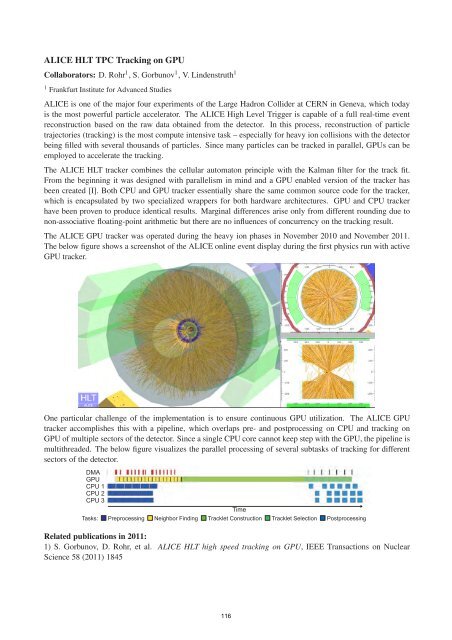FIAS Scientific Report 2011 - Frankfurt Institute for Advanced Studies ...
FIAS Scientific Report 2011 - Frankfurt Institute for Advanced Studies ...
FIAS Scientific Report 2011 - Frankfurt Institute for Advanced Studies ...
Create successful ePaper yourself
Turn your PDF publications into a flip-book with our unique Google optimized e-Paper software.
ALICE HLT TPC Tracking on GPU<br />
Collaborators: D. Rohr 1 , S. Gorbunov 1 , V. Lindenstruth 1<br />
1 <strong>Frankfurt</strong> <strong>Institute</strong> <strong>for</strong> <strong>Advanced</strong> <strong>Studies</strong><br />
ALICE is one of the major four experiments of the Large Hadron Collider at CERN in Geneva, which today<br />
is the most powerful particle accelerator. The ALICE High Level Trigger is capable of a full real-time event<br />
reconstruction based on the raw data obtained from the detector. In this process, reconstruction of particle<br />
trajectories (tracking) is the most compute intensive task – especially <strong>for</strong> heavy ion collisions with the detector<br />
being filled with several thousands of particles. Since many particles can be tracked in parallel, GPUs can be<br />
employed to accelerate the tracking.<br />
The ALICE HLT tracker combines the cellular automaton principle with the Kalman filter <strong>for</strong> the track fit.<br />
From the beginning it was designed with parallelism in mind and a GPU enabled version of the tracker has<br />
been created [I]. Both CPU and GPU tracker essentially share the same common source code <strong>for</strong> the tracker,<br />
which is encapsulated by two specialized wrappers <strong>for</strong> both hardware architectures. GPU and CPU tracker<br />
have been proven to produce identical results. Marginal differences arise only from different rounding due to<br />
non-associative floating-point arithmetic but there are no influences of concurrency on the tracking result.<br />
The ALICE GPU tracker was operated during the heavy ion phases in November 2010 and November <strong>2011</strong>.<br />
The below figure shows a screenshot of the ALICE online event display during the first physics run with active<br />
GPU tracker.<br />
One particular challenge of the implementation is to ensure continuous GPU utilization. The ALICE GPU<br />
tracker accomplishes this with a pipeline, which overlaps pre- and postprocessing on CPU and tracking on<br />
GPU of multiple sectors of the detector. Since a single CPU core cannot keep step with the GPU, the pipeline is<br />
multithreaded. The below figure visualizes the parallel processing of several subtasks of tracking <strong>for</strong> different<br />
sectors of the detector.<br />
DMA<br />
GPU<br />
CPU 1<br />
CPU 2<br />
CPU 3<br />
Tasks: Preprocessing Neighbor Finding Tracklet Construction Tracklet Selection Postprocessing<br />
Related publications in <strong>2011</strong>:<br />
1) S. Gorbunov, D. Rohr, et al. ALICE HLT high speed tracking on GPU, IEEE Transactions on Nuclear<br />
Science 58 (<strong>2011</strong>) 1845<br />
116<br />
Time
















